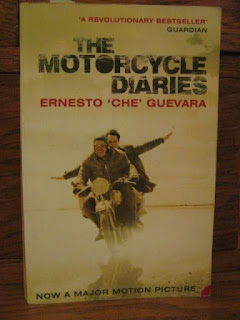I was left a little bemused by what the fuss is over this book. To begin with so little of the journey they take is on the motorbike that I felt the title was somewhat misleading; the bike disintegrates and has to be abandoned only a short time into the trip and they continue as hitchhikers, blagging lifts and accommodation and food along the way, using their kudos as medical students to good effect. And to be honest there is very little politics: it is often reviewed as a journey that formed him politically and led directly to his revolutionary ambitions and yet although he observes much in the way of deprivation and inequality in the communities they pass through his reaction is not always sympathetic and they were occasionally somewhat contemptuous of the illiterate indigenous people. They are travelling to see and experience the continent, as tourists, not to learn about the lives of the people. There is much more discussion of their own hunger than that of the poor people they encounter, and their talk is frequently directed towards acquiring some alcohol and recovering from the after-effects. The book is written very much as you might imagine a young man's diary; it is mostly a catalogue of where they went, how they got there, who they met, what they ate and so on, with elaborate descriptions of some of their most desperate hardships and dangerous scrapes. I think what I liked about the book is that it humanises the icon; Che becomes a real person, a real young man with the interests and concerns of a young man, and there are some very thoughtful and perceptive descriptions of the places they visit, showing Che as having a true appreciation of the history of the continent. But I do feel like I got to know him somehow and it reminded me of Boris Pasternak's letters and how it was their very ordinariness that allowed you to see the real person. Some of the writing is mundane but occasionally he waxes lyrical, so I'll give you one of those:
"EL OMBLIGO
the navel!
The word that most perfectly describes the city of Cuzco is evocative. Intangible dust of another era settles on its streets, rising like disturbed sediment of a muddy lake when you touch the bottom. But there are two or three Cuzcos, or it's better to say, two or three ways the city can be summoned. When Mama Ocllo dropped her golden wedge into the soil and it sank effortlessly, the first Incas knew this was the place selected by Viracocha to be the permanent home for his chosen ones, who had left behind their nomadic lives to come as conquistadores to their promised land. With nostrils flaring zealously for new horizons, they watched as their formidable empire grew, always looking beyond the feeble barrier of the surrounding mountains. And the converted nomads set to expanding Tahuantinsuyo, fortifying as they did so the centre of their conquered territory - the navel of the world - Cuzco. And here grew, as a necessary defense for the empire, the imposing Sacsahuamán, dominating the city from its heights and protecting the palaces and temples from the wrath of the enemies of the empire. The vision of this Cuzco emerges mournfully from the fortress destroyed by the stupidity of illiterate Spanish conquistadores, from the violated ruins of the temples, from the sacked palaces, from the faces of a brutalised race. This is the Cuzco inviting you to become a warrior and to defend, club in hand, the freedom and the life of the Inca.
High above the city another Cuzco can be seen, displacing the destroyed fortress: a Cuzco with coloured-tile roofs, its gentle uniformity interrupted by the cuppola of a baroque church; and as the city falls away it shows us only its narrow streets and its native inhabitants dressed in typical costume, all local colors. this Cuzco invites you to be a hesitant tourist, to pass over things superficially and to relax into the beauty beneath the leaden winter sky.
And there is yet another Cuzco, a vibrant city whose monuments bear witness to the formidable courage of the warriors who conquered the region in the name of Spain, the Cuzco to be found in museums and libraries, in the church facades and in the clear, sharp features of the white chiefs who even today feel pride in the conquest. This is the Cuzco asking you to pull on your armor and, mounted on the ample back of a powerful horse, cleave a path through the defenceless flesh of a naked Indian flock whose human wall collapses and disappears beneath the four hooves of the galloping beast.
Each one of these Cuzcos can be admired separately, and to each one we dedicated a part of our stay." (p.103-4)
 |
| Wikicommons |

Very interesting. I've actually never seen that poster before or read anything about this story. It sounds like an amazing journey. Scary too. Can you imagine?
ReplyDelete